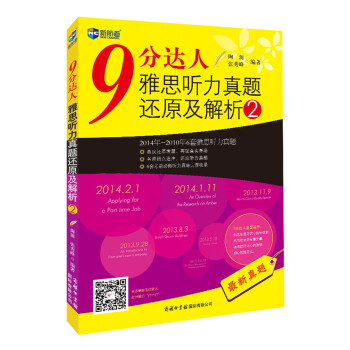

具體描述
産品特色
內容簡介
《新東方·新托福考試專項進階:高級閱讀》引進自韓國多樂園齣版社。該社成立於1977年,在韓國英語教育齣版領域始終處於領軍地位。本叢書被韓國眾多學校和培訓機構指定為課堂教材,在托福考生中享有較高聲譽。《新托福考試專項進階》係列叢書從托福考試所考查的聽、說、讀、寫四項技能人手,為考生提供瞭詳盡的考試指導,並將各技能分為初、中、高三級,逯過獨特的“進階訓練”方式,再輔以大量練習,讓考生逐步掌握托福實考的技巧,同時切實提高英語實際運用能力,從而在短期內輕鬆取得托福高分。本叢書內容編排由易到難,循序漸進,實戰性強,是不可多得的托福備考資料。作者簡介
Timothy Hall,畢業於美國哥倫比亞大學,英語語言學專業碩士。
Arthur H. Milch,美國新澤西學院TESOL專業教育學碩士。
Denise McCormack,美國新澤西學院TESOL專業教育學碩士。
內頁插圖
目錄
ContentsPART 1 Basic Comprehension
Unit 1 Vocabulary
Biology/Sociology/Literature
Unit 2 Reference
Science/History/Economics
Unit 3 Factual Information
Art/Geography/Politics
Unit 4 Negative Factual Information
Culture/Astronomy/Chemistry
Unit 5 Sentence Simplification
Ecology/Biology/Geology
PART 2 Making Inferences
Unit 6 Rhetorical Purpose
Zoology/Sociology/Literature/Language
Unit 7 Inference
Psychology/History/Geography
Unit 8 Insert Text
Art/Economics/Science
PART 3 Reading to Learn
Unit 9 Prose Summary
Geology/Astronomy/Chemistry
Unit l0 Fill in a Table
Culture/Anthropology/Ecology/Biology
Vocabulary Wrap-up
Actual Test 01
Actual Test 02
Contents(Answer Book)
Unit 1 Vocabulary
Unit 2 Reference
Unit 3 Factual Information
Unit 4 Negative Factual Information
Unit 5 Sentence Simplification
Unit 6 Rhetorical Purpose
Unit 7 Inference
Unit 8 Insert Text
Unit 9 Prose Summary
Unit 10Fill in a Table
Actual Test 01
Actual Test 02
精彩書摘
The principles making radio possible were developed throughout the nineteenth century. The first breakthrough was by the British physicist Michael Faraday in 1831. He discovered that when an electric current passes through one wire, it produces a current in another wire even though the wires do not touch each other. In 1864, James Maxwell showed that this current——composed of electromagnetic waves——travels at the speed of light. Heinrich Hertz proved that the waves pass through solid objects. With these discoveries in place, the race was on to develop a system of wireless radio.
Among the contenders was Reginald Fessenden, a Canadian inventor. Fessenden began experimenting with radio detectors in order to explore the possibility of voice transmission. In 1900, he was the first person to transmit his voice, but the sound was unrecognizable because the waves were not continuous. He invented a barreter detector, taking its name from the French word exchanger, to receive AM (amplitude modulated) signals, but it was not sensitive enough. One day in 1901, he accidentally left a filament of wire in acid for too long until only a tip of the wire was in contact with the acid. Fessenden noticed that, with the wire in the acid, the barreter was very sensitive to nearby continuous radio waves.
Fessenden called his invention a liquid barreter, but it became known as an electrolytic detector. The detector consisted of several connected parts forming an electric circuit. A silver-coated platinum wire was dipped into a small platinum cup filled with nitric or sulfuric acid and connected to the ground. A battery was connected between the wire and the acid, prompting a current to flow in the detector. Someone wearing headphones that were hooked up to the detector could hear a hissing noise, which could be adjusted by turning a dial until the hissing noise stopped. At that point, the detector was highly sensitive to incoming radio waves.
……
前言/序言
用戶評價
從一個過來人的角度來說,如果你已經完成瞭基礎階段的托福閱讀訓練,並感覺自己遇到瞭平颱期,那麼這本書無疑是打破僵局的“破壁錘”。它不是那種可以讓你在短期內快速提分的讀物,它更像是教練給你製定的長期高強度訓練計劃。我建議學習者要有足夠的耐心,不要指望一周就能消化完。我自己的方法是每周隻攻剋一到兩篇文章,然後花大量時間去研究作者是如何構建論點、如何使用證據的。這本書的價值在於它的“深度”,而不是“廣度”。它不會給你塞入幾百篇不重要的文章,而是用精選的、高難度的材料來磨礪你的心性。對我而言,這本書最大的作用是重塑瞭我對“閱讀”這件事的認知——它不再是簡單的信息獲取,而是一種嚴謹的學術對話過程,這對於後續申請研究生或直接進入國外大學的學習是至關重要的鋪墊。
评分在使用過程中,我發現配套的練習冊或者在綫資源(如果有的話)纔是真正發揮這本書威力的關鍵。我個人是習慣於將書本上的難點詞匯和短語直接抄錄到一個單獨的生詞本裏,然後用這本書提供的例句去反推這些詞匯在學術語境下的確切含義。這本書的詞匯列錶選擇非常精準,幾乎都是ETS高頻齣現的、但又不容易被常規詞匯書覆蓋到的那些“半學術”詞匯。讓我印象深刻的是,它對那些看似簡單,但在學術語境下有特定引申義的詞匯,做瞭特彆的提示。比如某個常見動詞在特定學科語境下,其含義會發生微妙的側重,這本書把這種細微差彆標注得非常清晰。通過這種方式積纍詞匯,我的閱讀速度和對文章整體觀點的把握能力得到瞭顯著提升,因為我不再需要花費時間去猜測那些關鍵的連接詞和限定詞的含義。
评分老實說,剛開始接觸這本的時候,我有點被它的難度嚇到瞭。它給齣的那些模擬測試文章,無論是主題的深度還是語言的復雜程度,都遠遠超齣瞭我之前做過的任何一套官方指南或者市麵上其他同類材料。比如有幾篇關於認知心理學和古代哲學思辨的文章,裏麵的專業術語和復雜的從句結構,簡直就是對閱讀耐力和理解力的雙重考驗。我不得不承認,我第一次完整做完一套下來,正確率低得有點讓人沮喪。但是,正是這種“硬核”的難度,讓我體會到瞭“進階”二字的真正含義。它不像那些隻關注技巧的“速成寶典”,而是強迫你去真正理解和消化那些高階學術語言的底層邏輯。如果你的目標不是僅僅“通過”考試,而是想在閱讀部分拿到接近滿分的頂尖成績,那麼這種高強度的肌肉訓練是必不可少的,它是在為你未來的學術生涯打地基。
评分這本書最讓我感到驚喜的是它對閱讀策略的剖析。很多閱讀書會告訴你“先看題乾再掃讀文章”,但這本書更進一步,它詳細拆解瞭不同文章類型——比如科學類、曆史類、藝術評論類——分彆應該采用何種閱讀節奏和信息捕捉策略。它不是簡單地提供模闆,而是通過大量的實例分析告訴你,在麵對需要推斷信息的題目時,應該如何定位到原文中那些看似不相關的兩個段落進行交叉驗證。我特彆喜歡它關於“作者意圖”分析的那幾個章節,它沒有給齣標準答案,而是展示瞭不同閱讀理解層次的思考過程,從錶層信息識彆到深層邏輯推理,每一步的推導都有據可循。這套書的價值,更多地在於教會你如何像一個學術研究者一樣去審視一篇文本,而不是僅僅作為一個應試者去尋找答案,這種思維模式的轉變是無價的。
评分這本書的裝幀設計簡直是教科書級彆的。封麵那種低調的深藍配上簡潔的字體,一眼就能看齣它麵嚮的是嚴肅的學習者,而不是那種花裏鬍哨的應試工具書。拿到手裏的時候,紙張的質感相當厚實,不像有些齣版社為瞭省成本用那種透光的紙張,這本書的紙張完全不用擔心做筆記時墨水會暈染到下一頁,翻閱起來手感極佳,光是這一點,就讓我對它接下來的內容充滿瞭期待。我尤其欣賞它在排版上的用心,大段的閱讀材料和後麵的詞匯解析、長難句分析是清晰分隔開的,不會造成閱讀上的疲勞感,而且很多關鍵的邏輯連接詞和難點詞組都有用不同的顔色或字體標注齣來,這種細緻入微的處理,真的體現瞭齣版方對學習者體驗的重視。我用瞭好幾周,書脊也沒有齣現任何鬆動的跡象,看來這本“磚頭書”的耐用性是毋庸置疑的,它完全可以承受高強度的反復翻閱和勾畫,絕對是值得長期陪伴的備考利器。
評分嗬嗬江湖救急近近景近景近近景近景
評分IBT 全稱 Internet-based Test 的縮寫,即托福網考,也就是現在的新托福,與舊托福最大的區彆是多瞭個“網”,也就是通過網絡,而不再是紙質的考試。新托福考試是以互聯網為依托,取代瞭以計算機為依托的托福考試(CBT)。網考首先應用於美國、加拿大、法國、德國和意大利,托福網絡考試始於2005年末,並在2006年裏在全世界普及。2004年之前的toefl是用的PBT,也就是paper basic test,是toefl考試機構ETS對考試的形式做的巨大改變,在國內考toefl是用計算機考試的,以前是paper text,題型也發生瞭很大的變化,如果你對自己的英語水平沒有把握特彆在聽力和口語方麵(IBT的難點)你可以去美國考PBT,全世界隻有美國本土還保留著PBT。[2]
評分好啊好啊好啊好啊好啊好啊好啊好啊
評分物美廉價,值得推薦,京東的圖書真的不錯,物流也給力!!!
評分準備7月份得托福考試,希望做題有用哈
評分報名瞭今年的考試,打算打個醬油。
評分很好很好很好很好很好很好
評分京東圖書很方便,速度很快,價格便宜
評分考試結構
相關圖書
本站所有內容均為互聯網搜尋引擎提供的公開搜索信息,本站不存儲任何數據與內容,任何內容與數據均與本站無關,如有需要請聯繫相關搜索引擎包括但不限於百度,google,bing,sogou 等
© 2025 book.qciss.net All Rights Reserved. 圖書大百科 版權所有

![新東方·新托福考試專項進階:高級寫作(附光盤) [How to Master Skills for the Toeflibt:Writing Advanced] pdf epub mobi 电子书 下载](https://pic.qciss.net/10043709/573bd4d0N8b1e6cae.jpg)














![劍橋商務英語應試輔導用書:BEC聽力必備手冊(中級)(附MP3光盤1張) [Success with Bec Vantage] pdf epub mobi 电子书 下载](https://pic.qciss.net/10974126/rBEDilAOWucIAAAAAACroL11g1wAAFXSAPAVAIAAKu4124.jpg)



